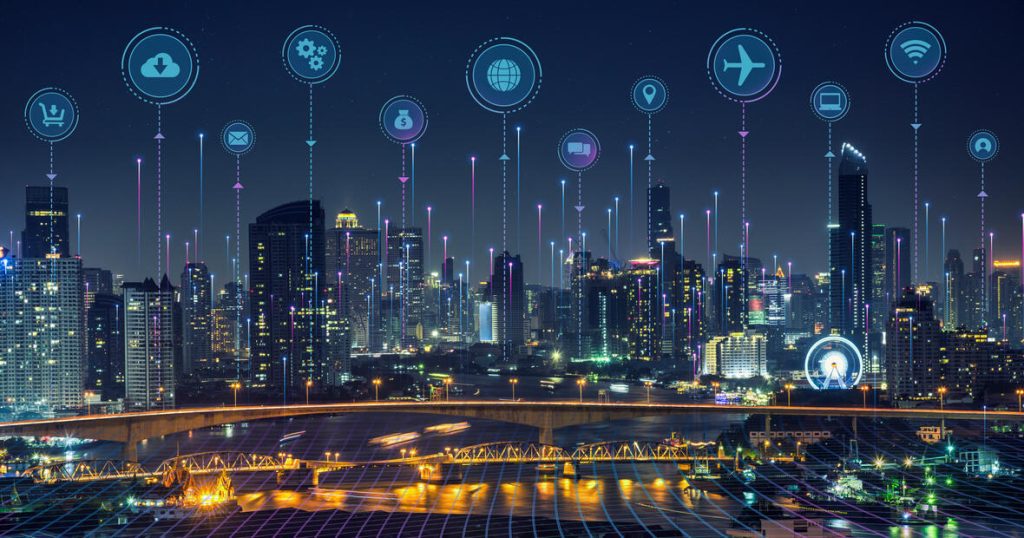In recent times our industry has seen a strong focus on digitalization. This push has led to the wealth of data we have at our fingertips today, offering valuable insights into how built assets function, and laying the foundations for transformative advancements.
Fast forward to today and the emergence of AI technology has brought a pivotal shift in how we leverage this information. AI has unlocked the potential to extract actionable intelligence from this data, enabling predictive analytics, pattern recognition, automation, and real-time optimisation. In short, it has revolutionised the way we interact with and harness the power of data within the built environment.
By harnessing the capabilities of AI, organisations can unlock new frontiers in operational efficiency, sustainability, and user experiences across diverse sectors. From smart buildings to infrastructure management, AI is reshaping the landscape of the built environment, offering unprecedented opportunities for innovation and progress.

One area where AI is making substantial impact is in the realm of energy management. Through advanced analytics and AI-driven insights, organisations can gain a granular understanding of energy consumption patterns, identify areas of inefficiency, and implement targeted strategies to minimise energy waste. AI-powered systems can analyse vast amounts of data from sensors and meters within buildings to optimise energy usage. By identifying patterns and predicting consumption, AI can help reduce energy waste, cut costs, and lower carbon footprints, contributing to more sustainable built environments. This not only reduces operational costs but also aligns with sustainability objectives, contributing to a greener and more environmentally conscious built environment.
Similarly, AI presents compelling use cases for sustainability and regulatory compliance in the built environment. By leveraging AI, organisations can analyse vast amounts of building data to optimise energy usage, reduce carbon footprint, and ensure adherence to environmental regulations. In terms of regulatory compliance, AI can look at the data to ensure adherence to environmental standards and regulations. Furthermore, AI-backed information retrieval, together with inclusion of conversational AI tools to existing sustainability-based applications can speed up the aggregation and visualisation of ESG data, helping to present it in a way that is easy for users to leverage.
Moreover, AI is transforming building operations. By leveraging IoT sensors and AI algorithms, AI-driven smart building systems can dynamically adjust environmental conditions such as lighting, temperature, and air quality based on occupancy patterns and external environmental conditions. Data analytics and machine learning allows for predictive analytics to anticipate heating and cooling demands for example, leading to proactive adjustments to system settings and airflow distribution. AI algorithms continuously fine-tune operations, resulting in energy savings without compromising comfort levels. This personalised approach not only enhances occupant comfort but also promotes personalised user experiences as well as energy efficiency by optimising resource usage based on real-time needs.
And in terms of building maintenance, by harnessing the power of machine learning and data analytics, AI enables proactive identification of potential equipment failures, enabling more advanced predictive maintenance capability and allowing for timely interventions and the avoidance of costly downtime. This proactive data-driven approach not only aids in maintaining optimal system performance but also facilitates predictive maintenance, preventing costly breakdowns, extending the lifespans of equipment, and enhancing energy efficiency, operational reliability and occupant well-being. Moreover, by integrating AI into maintenance scheduling and work order automation, organisations can achieve greater operational and resource efficiency, cost savings, and improved asset performance.
The integration of AI-driven automation with data analytics empowers organisations to streamline operations, reduce manual interventions, and improve overall asset performance. This leads to significant cost savings, improved energy efficiency, and a more comfortable and sustainable built environment for occupants.
Artificial intelligence, in the form of natural language processing specifically, also has the potential to greatly improve knowledge management in facility management. AI can efficiently analyse extensive volumes of facilities and asset data, a task that is currently impractical through manual methods alone. This not only captures crucial asset knowledge but also extracts and processes information and insights, thereby enhancing knowledge management and overall efficiency.
The influence of AI extends to space utilisation and design optimisation. Through data-driven insights and predictive analytics, AI empowers stakeholders to make informed decisions regarding space allocation, layout design, and resource utilisation, ultimately maximising the functionality and efficiency of spaces we occupy.
AI is playing a pivotal role in revolutionising the design and construction of built assets also. With the availability of data, AI-based applications have been finding more use-cases in construction. Some examples include:
- Optimising the design processes
- Running building simulations
- Enhancing risk management
- Streamlining project management
- Improving quality control and safety
- Optimising supply chain operations.
These advancements are driving increased efficiency, sustainability, and innovation in the construction industry, ultimately leading to the creation of smarter and more resilient buildings. One example in construction safety is an AI chatbot that can offer workers immediate access to a thorough database of legislative and risk assessment data using a natural language interface. This would allow users to ask site-related questions and receive clear safety guidelines for the tasks they are about to perform.
AI security is another rapidly evolving area. From a physical security perspective, AI can be applied to video surveillance cameras to automate and spot unusual patterns for example. AI is also used in access control and visitor management systems to streamline processes and minimise manual interventions, making buildings more responsive and safer for occupants.
With the abundance of data at our disposal today, along with increasingly intelligent IoT devices, cloud applications, and the widespread use of APIs for data exchange – new avenues have emerged for malicious cybersecurity actors to cause disruption. From a cybersecurity standpoint, AI plays an increasingly vital role, ranging from analysing OT network traffic to identifying abnormal behaviour that may indicate a cyber-attack, to processing large volumes of security data from OT systems to identify potential threats and vulnerabilities, just to name a few.
Steps for you to harness your AI capability
Step 1: Advance digitalisation to harness AI capability
The first step towards unleashing the potential of AI involves digitising existing data and workflows. In older buildings, manual worker intervention, pen-and-paper methods, or manual data entry via spreadsheets is still common. To prepare your assets to be able to harness the full power of AI, organisations need to digitalise their assets with digital solutions such as smart meters, IoT sensors, and cloud-connected operational technologies. This will allow you to be able to gather and analyse accurate real-time data. This phase of data capture and preparation is vital for unlocking organisational AI capability and enhancing decision-making.
Step 2: Break down data silos between departments and applications
This step involves eliminating data silos across departments and applications to ensure that AI-driven insights are based on comprehensive, multi-dimensional data sets. Relying on a single large data set is insufficient for generating actionable insights, as AI algorithms are designed to uncover connections and interdependencies. Many organisations face barriers between different departments and software applications, hindering data sharing. As part of your AI capability development and solution implementation, organisations must identify existing data silos and strategise their removal. Digital solutions like Schneider Electric’s Building Data Platform offer the ability to consolidate building data from various sources, including IT and OT, and analyse and contextualise it according to your specific needs.
Step 3: Identify use cases and applications of AI within your organisation
Start by assessing your business processes, operations, and pain points. Engage with various stakeholders to understand their specific needs and challenges, then explore how AI technologies can address these pain points and improve existing processes. Industry best practices and case studies can help you to gain insights into how AI has been successfully applied in similar contexts. Finally, prioritise use cases based on their potential impact and feasibility of implementation within your organisation.
In summary
The transformative impact of AI on the built environment and its assets is undeniable. As organisations embrace AI-driven solutions, they are poised to unlock unprecedented levels of operational efficiency, sustainability, safety, and resilience. By harnessing the power of AI, the built environment will evolve into a dynamic and intelligent ecosystem, driving towards a future defined by optimised performance, enhanced sustainability, and unparalleled human user experiences.



Add a comment